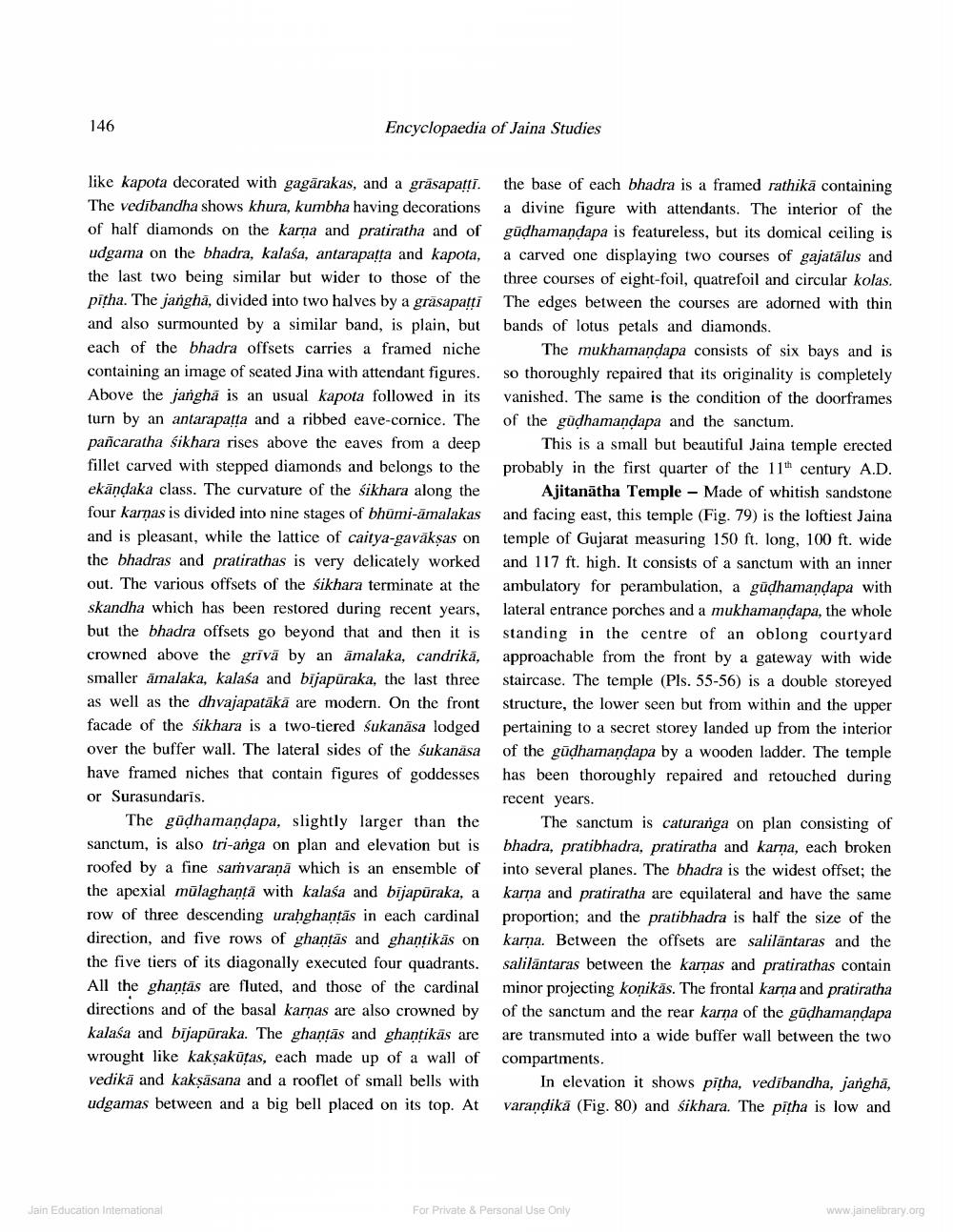________________
146
Encyclopaedia of Jaina Studies
like kapota decorated with gagärakas, and a gräsapatti. The vedibandha shows khura, kumbha having decorations of half diamonds on the karna and pratiratha and of udgama on the bhadra, kalasa, antarapatta and kapota, the last two being similar but wider to those of the pitha. The jangha, divided into two halves by a grāsapatti and also surmounted by a similar band, is plain, but each of the bhadra offsets carries a framed niche containing an image of seated Jina with attendant figures. Above the jangha is an usual kapota followed in its turn by an antarapatta and a ribbed eave-cornice. The pañaratha sikhara rises above the eaves from a deep fillet carved with stepped diamonds and belongs to the ekāndaka class. The curvature of the sikhara along the four karnas is divided into nine stages of bhūmi-āmalakas and is pleasant, while the lattice of caitya-gavākşas on the bhadras and pratirathas is very delicately worked out. The various offsets of the Sikhara terminate at the skandha which has been restored during recent years, but the bhadra offsets go beyond that and then it is crowned above the grivä by an amalaka, candrika, smaller amalaka, kalasa and bijapüraka, the last three as well as the dhvajapatäkä are modern. On the front facade of the Sikhara is a two-tiered sukanāsa lodged over the buffer wall. The lateral sides of the sukanāsa have framed niches that contain figures of goddesses or Surasundaris.
The gūdhamandapa, slightly larger than the sanctum, is also tri-anga on plan and elevation but is roofed by a fine saṁvaranā which is an ensemble of the apexial mūlaghantă with kalaśa and bijapūraka, a row of three descending urahghantās in each cardinal direction, and five rows of ghantās and ghantikās on the five tiers of its diagonally executed four quadrants. All the ghantäs are fluted, and those of the cardinal directions and of the basal karnas are also crowned by kalaśa and bijapūraka. The ghantās and ghantikās are wrought like kakşakūtas, each made up of a wall of vedika and kaksäsana and a rooflet of small bells with udgamas between and a big bell placed on its top. At
the base of each bhadra is a framed rathikā containing a divine figure with attendants. The interior of the güdhamandapa is featureless, but its domical ceiling is a carved one displaying two courses of gajatālus and three courses of eight-foil, quatrefoil and circular kolas. The edges between the courses are adorned with thin bands of lotus petals and diamonds.
The mukhamandapa consists of six bays and is so thoroughly repaired that its originality is completely vanished. The same is the condition of the doorframes of the gūdhamandapa and the sanctum.
This is a small but beautiful Jaina temple erected probably in the first quarter of the 11th century A.D.
Ajitanātha Temple - Made of whitish sandstone and facing east, this temple (Fig. 79) is the loftiest Jaina temple of Gujarat measuring 150 ft. long, 100 ft. wide and 117 ft. high. It consists of a sanctum with an inner ambulatory for perambulation, a gudhamandapa with lateral entrance porches and a mukhamandapa, the whole standing in the centre of an oblong courtyard approachable from the front by a gateway with wide staircase. The temple (Pls. 55-56) is a double storeyed structure, the lower seen but from within and the upper pertaining to a secret storey landed up from the interior of the gūdhamandapa by a wooden ladder. The temple has been thoroughly repaired and retouched during recent years.
The sanctum is caturanga on plan consisting of bhadra, pratibhadra, pratiratha and karna, each broken into several planes. The bhadra is the widest offset; the karna and pratiratha are equilateral and have the same proportion; and the pratibhadra is half the size of the karna. Between the offsets are saliläntaras and the saliläntaras between the karmas and pratirathas contain minor projecting konikäs. The frontal karna and pratiratha of the sanctum and the rear karna of the gudhamandapa are transmuted into a wide buffer wall between the two compartments.
In elevation it shows pitha, vedibandha, janghā, varandikā (Fig. 80) and Sikhara. The pitha is low and
Jain Education Intemational
cátion Intermational
For Private & Personal Use Only
For Private & Personal Use Only
www.jainelibrary.org




